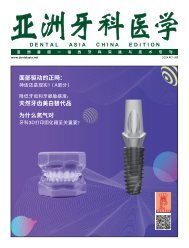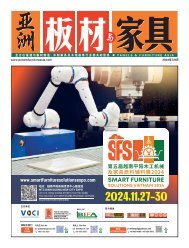Dental Asia May/June 2020
For more than two decades, Dental Asia is the premium journal in linking dental innovators and manufacturers to its rightful audience. We devote ourselves in showcasing the latest dental technology and share evidence-based clinical philosophies to serve as an educational platform to dental professionals. Our combined portfolio of print and digital media also allows us to reach a wider market and secure our position as the leading dental media in the Asia Pacific region while facilitating global interactions among our readers.
For more than two decades, Dental Asia is the premium journal in linking dental innovators
and manufacturers to its rightful audience. We devote ourselves in showcasing the latest dental technology and share evidence-based clinical philosophies to serve as an educational platform to dental professionals. Our combined portfolio of print and digital media also allows us to reach a wider market and secure our position as the leading dental media in the Asia Pacific region while facilitating global interactions among our readers.
You also want an ePaper? Increase the reach of your titles
YUMPU automatically turns print PDFs into web optimized ePapers that Google loves.
Clinical Feature<br />
Guided Implantology:<br />
the SMART Guide<br />
By Dr. George Freedman and Dr. Mark Antal<br />
The tremendous proliferation of<br />
implant services worldwide has<br />
created a need for simplified<br />
and more predictable treatment<br />
guidance modalities. There<br />
are currently a number of surgical guide<br />
platforms that are available, but most<br />
systems are strictly limited to specific<br />
implant catalogues, typically the products<br />
sold by the surgical guide sponsor. Other<br />
surgical guides are open systems and allow<br />
the practitioner to use any selected dental<br />
implant. The practitioner has the options<br />
of freehand, partially guided, and fully<br />
guided implant placement surgery. Guided<br />
surgery results in more accurate results than<br />
freehand surgery. Computerised treatment<br />
planning and guided surgery improve<br />
accuracy, predictability and patient care.<br />
Patient-centred treatment planning<br />
Given the wide selection of high-quality<br />
implants that can be utilised by the dental<br />
practitioner, it makes more sense to develop<br />
a treatment plan based on the patient’s<br />
needs and anatomic suitability rather<br />
than on a specific implant manufacturer’s<br />
product lines, due to the large variation in<br />
cost and the regional disparity in product<br />
access. Thus, the ideal guidance system can<br />
be adapted to a variety of implant brands<br />
and types, offering recommendations that<br />
are patient-centred rather than productcentred.<br />
The SMART Guide Technology System<br />
(dicomLAB <strong>Dental</strong> Ltd., Szeged, Hungary)<br />
provides a complete case analysis and<br />
preparation shortly after imaging, enabling<br />
immediate treatment planning for any type<br />
of implant placement; it is possible to set<br />
the implant length with 0.5mm increments<br />
and the diameter with 0.1mm accuracy. The<br />
surgical protocol of the system is entirely<br />
dependent on the properties of the implant<br />
which is selected by the practitioner. The<br />
shape of the implant is also at the discretion<br />
of the dentist – conical or parallel shapes<br />
can be selected.<br />
CBCT and intraoral impression<br />
The following presentation is a detailed,<br />
step-by-step presentation of a case<br />
where planning and surgery were both<br />
accomplished with the assistance of the<br />
SMART Guide system.<br />
Fig. 1: Panoramic radiograph<br />
Fig. 2: Virtual model of #24 fractured<br />
Fig. 3: Virtual model of #24 fractured with SMART<br />
Guide visualisation<br />
A 39-year-old female patient presented a<br />
broken left upper first bicuspid, tooth 24.<br />
The tooth has had endodontic treatment;<br />
a subsequent vertical fracture of the root<br />
and unrestorable coronal structures made<br />
the case for an implant treatment the best<br />
choice.<br />
The remaining dental structures of tooth<br />
24 were extracted. In order to avoid any<br />
complications due to residual bacteria or<br />
possible periapical or periradicular infection,<br />
a two-month healing time was mandated.<br />
After the initial healing step, a CBCT was<br />
taken, and an intraoral impression of the<br />
patient was made with a custom-made<br />
plastic impression tray and C-silicone. This<br />
is the SMART Guide Simple CBCT Protocol.<br />
This approach does have some limitations<br />
as the superimposition of the CBCT to the<br />
silicone impression requires the presence<br />
of a minimum of eight sound teeth to be<br />
present as reference points on the dental<br />
arch to be treated. The silicone impression<br />
must be scanned with an extraoral scanner<br />
38<br />
DENTAL ASIA MAY / JUNE <strong>2020</strong>


















